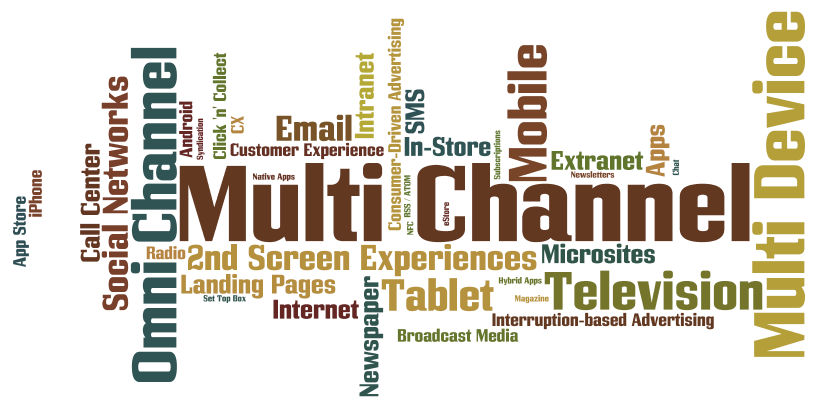From McDonald’s “I’m lovin’ it” to Apple’s “Think Different” till Dove’s “Real Beauty” campaign and Skittles’ “Taste the Rainbow” campaign, marketing campaigns have a huge impact on how your brand is perceived and remembered.

Marketing campaigns are a crucial part of brand marketing, sales strategy, as well as one of the keys for ensuring your business’s success. If carried out properly, your marketing campaigns would be able to secure high returns on investment, gross profits, and increased customer loyalty.
This is because marketing campaigns make the companies memorable while also persuading your customers to take the desired action. They give an identity and personality to your brand while expressing the emotions that will help you connect with your buyer personas.
To become the ultimate guide to marketing campaigns, this article will cover the following topics:
- What is a Marketing Campaign?
- Marketing Campaigns vs. Advertising Campaign
- Marketing Campaign Components
- 10 Steps for Creating a Successful Marketing Campaign
- Types of Marketing Campaigns
- Where Do Types of Marketing Campaigns Fit Within Your Sales Funnel?
- Top Marketing Campaign Examples
- How Can Deskera Help You With Marketing?
- Key Takeaways
- Related Articles
What is a Marketing Campaign?
Marketing campaigns are organized, strategized efforts to promote a specific company goal like increasing brand awareness, raising awareness for a new product or service, capturing customer feedback, and so on.
Typically, marketing campaigns aim at reaching the consumers in a variety of ways through a combination of media, including but not limited to email marketing, print advertising, television or radio advertising, pay-per-click, social media marketing, e-marketing, and so on.
What needs to be understood is that a marketing campaign does not include all the marketing efforts like a marketing strategy does. Marketing campaigns include only those connected series of operations that are designed to bring about a particular result. A good marketing campaign is one that follows a consistent theme to promote a single or focused idea or goal.
For example, if on your way to work, you see a Nike billboard promoting its one specific product, scroll past a Nike sponsored Instagram post for the same product, and even receive a Nike email promoting that product that you have just come across a marketing campaign designed for promoting that specific Nike product.
Hence, specific goals that you might have for your marketing campaign are:
- Reducing negative publicity
- Building a brand image
- Repositioning your brand positioning statement
- Introducing a new product
- Increasing affiliate and referral sales
- Revamping an existing product or service
Marketing Campaign vs. Advertising Campaign
Advertising is a part of marketing. While marketing is the entire plan of your company to raise brand awareness and persuade the customers to make the purchase. On the other hand, advertising is about creating persuasive messages around the above-mentioned brand goals so that through advertising, you can meet your marketing goals.
Considering this, advertising campaigns is a facet of the overall marketing campaign. For example, if Nike were campaigning about the release of a new product, then their advertising would be a part of their broader marketing efforts which might also include video marketing, YouTube marketing, digital marketing, affiliate marketing, attraction marketing, paid search engine marketing and so on.
Marketing Campaign Components
There are multiple marketing campaign components that go into the planning and execution of a stellar marketing campaign for you to benefit from. These are:

Goals and KPIs
You should identify the end goal of your marketing campaign, quantify it and explain how you will measure this result. For example, your content creation campaign can be measured in terms of organic traffic that it brought in.
Channels
This is an important component of marketing campaigns as it will help you decide where your content and messaging will get distributed and hence reach your target audience. For example, if you are into social media marketing campaigns, you will choose to carry out on Instagram if you see it as a more relevant channel for your audience than other platforms like Pinterest or Twitter. This will also help you in increasing your loyal following.
Budget
To determine your budget, you should consider marketing agency costs, advertising costs, freelancing costs, and others as applicable. You should also try to estimate your return on investment on these expenses. This will help you determine how you can improve your campaign and increase your operating income while decreasing your operating expenses, thereby improving the cash flow of your business.
Content Format
Here, you will determine the kind of content you would be making to fuel your marketing campaign. You can even include multiple content formats in a singular campaign. For example, a brand awareness marketing campaign can include video ads, press releases, and even guest blogs.
Team
Who is a part of your team who will help you with copywriting, website building, design, budget planning, video, any other elements that you are going to use in your marketing campaign?
Design
Designing your marketing campaign is very important as not only is it a reflection of your brand image but also stays with your audience for a long time. Your marketing campaign should hence have a noteworthy design like, for example, a sleek website design, a logo at the end of a video commercial, an interactive infographic, etc. Your design should be professional and meet the needs of your marketing campaigns as well.
10 Steps for Creating a Successful Marketing Campaign
While planning and designing your marketing campaign can become pretty complex, it is not so if you have a template to guide you through it. This section of the article is kind of a template for your marketing campaign, and you would just need to answer the questions as much in detail as you can.
Also, do not skip any questions as they are all interlinked and while answering them, keep in mind what you want your audience to do when they see/ hear/ read your marketing campaign’s content.

Deciding the Purpose and Goals of Your Marketing Campaign
- Why are you running this marketing campaign?
- What would you like this marketing campaign to achieve for your business?
For example, Your goal is to gather customer feedback or content. Your goal should, however, be a SMART (i.e., Specific, Measurable, Attainable, Relevant, Timely) goal. Hence, your SMART goal here would be- "the goal of my marketing campaign is to gather user-generated content from 50 customers via a branded hashtag on Twitter featuring our new product line by January 2022."
How You Will Measure Your Marketing Campaign’s Performance and Success?
Depending on your goals and your business, how you will measure your marketing campaign’s performance, and success will vary. For example,
- If you want to promote a new product or service: Measure it through pre-orders, sales, upsells
- If you want to increase brand awareness: Measure it through sentiment, social mentions, press mentions.
- If you want to gather customer feedback or content: Measure it through engagement, social media mentions.
- If you want to generate more revenue: Measure it through leads, sales, upsells, change in the income statement.
- If you want to boost user engagement: Measure it through blog shares, social shares, email interactions.
- If you want to advertise for an upcoming event: Measure it through ticket sales, vendor or entertainment bookings, social mentions.
However, if your marketing campaign is using multiple mediums, then you should note down how you will measure your marketing campaign on each medium. In addition to this, you should also note down milestones in your path to achieving your final goal. This would help in boosting the morale of yourself and your team, manage workplace stress and even ensure that you continue to be on the right track.
Hence for example, if your marketing campaign is about boosting brand awareness and your primary goal is to reach 50 PR mentions in a year, then you should set up your milestones at 10, 25, and 40 mentions and do a little celebration at each one of them.
Defining Your Target Audience
Aligning with your audience and how you do it can make or break your marketing campaign, making this one of the crucial components of a marketing campaign. Some of the things you need to consider while defining your target audience are:
- What stage of the buyer’s journey is your marketing campaign targeting?
- Is your goal to get new customers? Or is it to get feedback from the existing ones?
- Are you marketing your brand to those who recognize it? Or are you introducing a new brand identity altogether?
Depending on whether your audience is in the awareness, consideration, or decision stage, your marketing message will vary. However, always remember that your marketing campaign can also include collateral for people in various stages of their journey. For example, while your marketing campaign is targeting current customers, it can also bring brand awareness to new customers.
You can understand your audience even better by answering questions like these:
- What are your audience’s general interests? What magazines or newspapers do they read? Which TV shows do they watch the most? On which social media platform are they most active? How do they spend their free time?
- For what purpose do they use different social media platforms? Do they engage, or do they merely browse through a particular social media platform?
- What kind of content grabs your audience’s attention? Are they more likely to respond to straightforward sales messages? Or are they more likely to respond to witty, humorous content? What cultural references are they most likely to understand?
- What are the problems and challenges that they are facing, and how can I solve them through my products or services?
And so on.
Setting a Concept For Your Marketing Campaign and Getting the Right Team For It
Here you will talk about how your marketing campaign will look like. Marketing campaigns like a brand require their own mission, vision, and visual identity. This is why great marketing campaigns are a visual and creative offshoot of their parent brand.
When creating your marketing campaign assets, you can have in-house teamwork on it or hire an agency or freelancer, or contractor to complete a specific campaign. However you choose to get your marketing assets made, what matters is how well they understand what needs to be done and achieved. After your marketing assets are ready, you will distribute them as planned in the previous steps. What your audience will see and when.
Choosing the Channels for Running Your Marketing Campaign
Here, you will choose the type of marketing that your campaign will use. This choice will get determined by your audience’s preferences, budget, brand engagement factors, and other such relevant factors.
To decide, you can even look at the current marketing channels that you are using and which one is performing the best. Amongst the ones you are already using, you should check which one will let you pay for your advertisements, which has the highest engagement, and where your audience is hanging out the most.
Also, while using multiple media channels is recommended, you should continue using only those channels where you already have a strong footing and not on those channels where you have none. Even if you choose not to use a particular channel, you can always use it to mention your campaign and therefore optimize it.
For example, you can update your social media bios, change your email signatures, install a website notification bar, add small CTAs at the bottom of blog posts, and so on. While such things take minimal effort, they do go a long way in promoting your marketing campaign.
Setting Timeline For Your Marketing Campaign
Setting a timeline for all your marketing campaign activities and then a final deadline for the campaign will help in giving you an idea of when, how, and how often you will promote your marketing campaigns.
After setting a basic timeline for your marketing campaign, you should take a look into your marketing assets and chosen marketing channels along with your financial resources so that you can determine how often you would be able to afford to post and promote your campaign content. You can also use a calendar to keep track of your marketing campaign activities.
With this marketing campaign component, we have covered the connected part and the operations part. The last part is about conversions so that you can get your decided results.
Ensuring Your Campaign is Driving Users towards the Desired Action
This step and component of a marketing campaign is all about calibrating your marketing efforts and channels in the manner that it leads your customers to complete your desired goals. This is done through conversion assets like lead forms, CTAs, landing pages, etc. These conversion assets can either be used individually or with each other. For example, having a CTA asking your audience to fill out your lead form on your landing page.
Monitoring the Right Metrics
Depending on your marketing campaign and the marketing channels on which you are running them, you will decide the metrics with which to measure its success. Some of the metrics you should watch as per their marketing channels are:
Email Metrics
- Click-through rate
- Bounce rate
- Conversion rate
Paid Social Media Metrics
- Click-through rate
- Conversion rate
- Cost per click
- Cost per conversion
Organic Social Media Metrics
- Passive engagements (likes and shares)
- Active engagement (comments)
- Follows
- Click-through rates
Lead Magnet/Content Offer Metrics
- Opt-in rate
- Cost per opt-in rate
- Follow-up email open rate
- Opt-in conversion rate
Display Ads/Paid Media Metrics
- Cost per thousand impressions
- Click-through rate
- Conversion rate
- Cost per conversion
Direct Mail Metrics
- Response rate
- Cost per conversion
- Average revenue per conversion
Content/SEO Metrics
- Click-through rate
- Bounce rate
- Time on page
- Page scroll depth
- Conversion rate
Following these metrics will help you assess your campaign accurately, helping you understand what and how to improve and also what to not do in the next marketing campaign. It will also help you secure long-term profits and revenue for your business.
Establish Success Numbers and Metrics
If your marketing campaign has met your SMART goal, you have definitely succeeded. However, if it has not been met, you can still be successful. For example, if your SMART goal was to increase organic blog views by 100k, then any and every increase in the views is considered to be a success.
However, what matters is whether your marketing campaign just worked or was it worthwhile. Your marketing campaign is worthwhile only if your returns on investment is proportionate to the time, energy, and finances that you invested in it. Thus, sticking to your SMART goal and calibrating your investment will ensure a worthwhile marketing campaign.
What To Do With Your Marketing Campaign Data?
Your marketing campaign data is very important for your future success as by analyzing and applying it, you would be able to identify your strengths and opportunities and prepare for your threats and weaknesses.
It will give you a better understanding of your target audience, marketing methods that work and do not work for you, identifying your creative prowess, and many more such insights. Hence, whether you have collected lead information, pre-orders, social engagements, or offer downloads, your marketing campaign data will not only help you meet your marketing campaign’s primary goals but also help you expand your marketing efforts as a whole.
Lastly, sit down with your marketing team to review your marketing campaign and ask yourselves questions like:
- What could you have done differently?
- How could you have saved money?
- For something that went wrong- probable reasons behind why it went wrong?
- What did you learn about your target audience?
- What did you learn about your marketing channels?
- What kind of feedback were you able to gather from your participants or customers?
And other such questions and brainstorming that will help you with your next marketing campaign.
Types of Marketing Campaigns
There are many types of marketing campaigns. Which type of marketing campaign you choose to use depends on your product or service, target audience as well as your brand image. Some of the most commonly used types of marketing campaigns are:

Product Marketing Campaign
A product marketing campaign is one that needs to take these four areas into consideration:
- Product
- Marketing
- Customer success
- Sales
This hence means that prior to the launch of your product marketing campaign, you will have to understand your target customer’s pain points and needs and how your messaging and positioning should be done so that it answers that. You will also need to understand the sales cycle as well as the niche of your product or service and your business.
After the product marketing campaign, however, you will be looking into various marketing key performance indicators as well as checking whether your initial sales number goals were met or not. This will help you determine how to continue driving ongoing demand for your product.
Hence, the three components which make up product marketing campaigns are:
- Messaging and positioning
- Making sure your customer’s get the value of your product during the launch
- Driving continuous product demand and usage
These three components will determine the content of your marketing products, whether it is landing pages or niche marketing or Facebook marketing, or any other forms of marketing. But before that, it will also help you to choose between the different types of marketing and various marketing channels. Ultimately, all of these will help you meet your marketing objectives like increased sales, higher customer retention, and closing deals faster.
For example, Apple’s 2007 iPhone Launch by Steve Jobs. Steve Jobs gave a MacWorld keynote in 2007 that demonstrated Apple’s mastery over phones- “reinventing the phones” and giving the world a smartphone that had a wide touchscreen, music, calling, and internet features all in one. Apple understood that its audience was ready for this “best of all worlds” product solution, and it designed its product marketing campaign accordingly. See Job’s keynote here:
Acquisition Marketing Campaign
A customer acquisition marketing campaign is one that not only raises awareness about the solution offered by your brand but also helps in acquiring more leads, new email subscribers, and customers. However, there are many types of marketing campaigns that fall under customer acquisition marketing campaigns. This is because customer acquisition cannot be achieved only through one step or through one funnel. Rather, it is a continuous process that uses different marketing campaigns to achieve its goals.
Acquisition marketing campaigns are top-of-the-funnel marketing strategies as they make your cold leads aware of your brand as well as products and services. It hence includes:
- Brand awareness
- Lead generation
- Social media
After acquisition marketing campaigns, your leads are moved down the sales process from the awareness stage to the conversion stage. Often this is done through offering educational content to keep your prospects interested, engaged and make them opt-in to your email list. This hence involves content marketing as well as CTAs.
For example, Dropbox uses a referral acquisition strategy wherein it gives you free space if you invite your friends to use it.
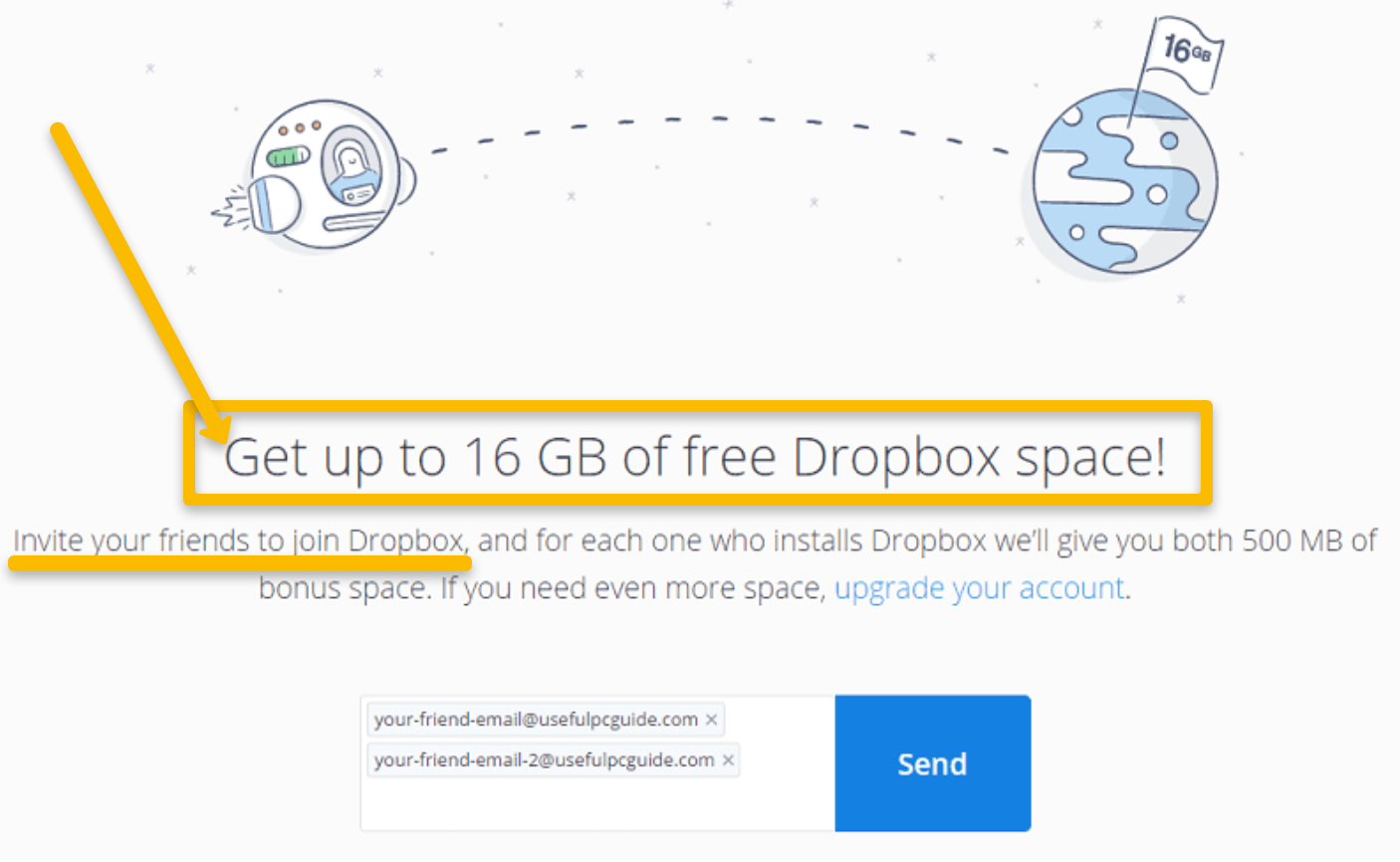
Always remember that acquisition marketing campaigns are less about profits and more about acquiring buyers and subscribers. This will ensure that you have higher net profits down the funnel, which will ultimately lead to high returns on investment.
Social Media Marketing Campaign
A successful social media marketing campaign consists of the following four components:
- Well-developed plan- You should start developing your plan by analyzing your existing social media accounts and their followers. Then set up your social media marketing team and assign them various marketing job roles involved with promotion, design, messaging responsibilities, editor, and so on. Set your budget.
- Defined goals- Some of the goals you can set for your social media marketing campaign are increasing brand awareness to set yourself apart from your competitors and when your business is new, increasing website traffic or social media followers, and driving the traffic from the social media to your website, improving conversion rates via web forms where your followers sign up for discount offers or newsletter lists and many more.
To measure how well you are achieving these goals, you should track metrics like ACV and ARR, assisted social conversion, total site entries, total conversions, time spent on the site, total visits on your website and on your social media pages, number of influencer mentions, followers counts, number of times your app got downloaded and any other relevant metrics as per your marketing goals.
- Cross-channel promotion- You should use a multi-channel approach in your social media marketing campaigns so that your prospects get reminded about your products, services, and offers through varied platforms like website retargeting ads, text messaging, email marketing, social media sponsored posts, reminders through influencer marketing, etc.
- Final analysis- Here, you will have to measure how well your social media marketing campaign has performed in terms of engagement metrics, customer lifetime value, new sales volume, etc.
For example, Starbucks started a #WhatsYourName social media marketing campaign in early 2020 that supported gender-diverse and transgender youth who used YouTube, Facebook, Twitter, Instagram. This marketing campaign was based on the well-known custom of writing your name on your cup while visiting their stores. Watch it here:
Paid Advertising Campaign
You can use one or all four of these paid advertising campaign types:
- Paid search marketing campaign- This is also known as search engine marketing. Paid search marketing campaign involves a strategy where you use image and text ads on platforms like Bing and Google.
- Display marketing- This type of marketing campaign involves the use of display networks that delivers the ads to the website visitors by using retargeting technology to serve ads as per their web browsing history and trends. It is similar to SEM.
- Paid social media marketing- Through this marketing campaign, social media users are targeted with video and image ads that are based on their interactions and insights.
- Influencer marketing- Here, influencer relationships are used to promote your products more personally through people- i.e., influencers who have a large social following.
When using this type of marketing plan, you should also consider using Google Ads. When doing so, you should also follow Google’s guidelines to improve your google ads quality score. Further on, you can even use A/B testing on an ad copy to improve your ad rankings as well as decrease average bid costs.
When resorting to paid marketing campaigns, you should also pay attention to geographic metrics to find out where your campaigns perform the best and give more qualified leads as well as higher conversion rates. In fact, you can even use the information provided by Google Analytics to find those website landing pages that are beneficial to your visitors but are not doing well organically. Their performance and traffic can be boosted through a paid advertising campaign.
Content Marketing Campaign
A content marketing campaign is entirely different from a content marketing strategy that you would already have running. You should run a content marketing campaign for over a period of 30 to 90 days. It should be focused on a specific audience or topic. Before running your content marketing campaign, you should set specific goals like generating leads, raising brand awareness, generating additional social media engagement, or making a blog post go viral.
Based on your goals and your buyer personas, you will have to develop your content ideas for your content marketing campaigns. After this, you should use a marketing planner to ensure a successful campaign with a well-organized team behind it.
In your marketing planner, you would have to identify the assets that you would be using like:
- Videos
- Ebooks
- Blog posts
- Whitepapers
- Online courses
- Landing pages
- Social media posts
- Infographics
And so on.
After deciding the assets you would be using for your content marketing campaign, you would be required to identify your keywords based on relevance, competition, and volume. Your keywords should make it easy for you to create informative and helpful content on the chosen topic. Post this, you would have to decide your channel of distribution like your website, social media, email, etc.
Email Marketing Campaign
To have a successful email marketing campaign, the first step is to establish well-set goals like:
- Improving welcome sequence so to educate your leads about your value
- Promoting content engagement. For example, raising awareness about a webinar that you are organizing.
- Nurturing your subscribers more effectively.
- Re-engaging inactive subscribers
- Segmenting your subscribers so that you can deliver content that is more relevant to them
- Creating effective lead magnets like short videos, quizzes, giveaways, eBooks, whitepapers, etc.
- Capturing new subscribers through blog post content upgrades, homepage lead magnets, light-box popups, exit-intent popups, etc.
To have an effective email marketing campaign, you would also need to have a well-thought-out frequency of sending your emails. For example, in the first week, when you are involved with a welcome email campaign, you can keep a frequency of once per day so that your subscribers get used to receiving these communications. In case if you are going to send newsletters, you can keep their frequency like weekly, biweekly, or monthly.
Lastly, when engaging in email marketing campaigns, you would have to pay special attention to crafting your:
- Subject lines
- Email copy
- Call-to-actions (which should match the overall objective of your campaign)
User-Generated Content Campaign
A user-generated content marketing campaign consists of blog and social media posts that your customers use to share their love for your brand, products, and services. User-generated content is a very powerful form of marketing because:
- They directly tell your friends and family that they need to check out your brand. It is trustworthy and special.
- Your audience is creating content for you which does increase the probability of that content connecting with more audiences like themselves, hence increasing your leads.
You can start your user-generated content marketing campaign on any platform of your choice like Twitter, Instagram, Facebook, etc. While doing so, you should use a unique hashtag. This will help in finding all the content that the campaign has generated for your business. You should also create your call-to-action. However, it should be kept simple. For example, a make-up brand might use this- show us your favorite eye-shadow color on Twitter with #myfaveyeshadow.
One of the most important parts of running a successful user-generated content marketing campaign is responding and engaging with your audience when they participate. This will show your customers that the campaign is as important to you as it is to them. Hence, the more you engage, the higher are the chances of your campaign taking off.
For example, in 2013, Heineken ran a user-generated content marketing campaign where it encouraged its customers to redefine the way people older than 60 years consume beer. This campaign was called the “60+ challenge,” and it encouraged its customers to share their own ideas, images, and even videos. This campaign received entries from more than 19 countries.
Watch this video of the campaign below:
Brand Awareness Marketing Campaign
This type of marketing campaign’s main goal is to get your brand in front of as many people as possible. The five steps you should follow in order to run a brand awareness marketing campaign are:
- Know your audience- You should map out your audience on the basis of their gender, age, disposable income, location, job title, industry, and salary.
- Determining where your audience hangs out online- Instead of advertising on LinkedIn, Pinterest, YouTube, Facebook, Twitter, or Instagram in an attempt at putting your brand name everywhere, you should use that specific platform that your social media statistics show as the best place to invest in advertising.
- Stick to a budget- Without a budget, you risk hampering your business’s cash flow and inviting unwanted trouble. Sticking to the budget will help you to avoid this while also helping you decide where you should advertise. For example, if you have a small budget, which platform will get you in front of a large audience? Could you get your brand awareness marketing campaign done for free? Maybe through podcasts or guest posts?
- Know your goals- Only if you have specific goals would you be able to know whether your brand awareness marketing campaign was successful or not. For example, if brand awareness is your sole goal, or do you also want to track changes in your website visits and email subscribers?
- Track the results- You should track all your relevant marketing KPIs so that you can get a deeper understanding of the success or failure of your brand awareness marketing campaign. This knowledge will help you make the necessary changes in future campaigns such that you would be able to better achieve your marketing goals. A tracking phone number, in its turn, can be used in marketing campaigns to track call metrics in marketing strategies.
For example, the tongue-in-cheek IHOP campaign announced that they were going to change their name to International House of Burgers. This brand awareness marketing campaign generated over 35 billion social media impressions and around 20,000 articles. View this campaign below to get ideas on how your company can do something similar:
Affiliate Marketing Campaign
Affiliate marketing has been on the rise for quite a while now, and it is expected that it will continue to be so. In affiliate marketing campaigns, your business will have third-party members sharing your brand’s links and banners on their sites or social media posts. These will be the affiliate links that will direct the clicker to your desired landing page.
Each time these links get clicked, your affiliate will get a fixed set of commissions or percentage of the sale made. By using affiliate marketing software, you would not only be able to get in touch with affiliates but also set up unique affiliate links and even be able to track the sales generated through those links by using cookies and pixels on each link.
Additionally, a good affiliate marketing software will also give you analytics and raise red flags when something seems off. You would also be able to manage all your affiliate partners on one platform.
After this, you would have to do your research and find the perfect affiliate partners for yourself and the niche that you have.
Where Do Types of Marketing Campaigns Fit Within Your Sales Funnel?
While there are many types of marketing campaigns and definitely more than the nine types we discussed above, this section of the article will give you an idea of which type of marketing campaign fits within a particular section of your sales funnel.
Top of the Funnel Marketing Campaigns
- Acquisition marketing campaign
- Partnership campaign
- Event registration campaign
- Visual/infographic asset campaign
- Research asset campaign (using company research for contents, options, etc.)
- Brand marketing campaign
- Roadshow campaign
- Contest/ sweepstakes campaign
- Traditional media campaigns (for example, TV, print, out-of-home)
Middle of the Funnel Marketing Campaigns
- Content marketing campaign
- Email marketing campaign
- Re-targeting campaign
- Re-engagement campaign
- Direct mail brand campaign
Bottom of the Funnel Marketing Campaigns
- Case study campaign
- Demo ad campaign
- Product marketing campaign
- Direct mail demo campaign
However, what will truly determine this is the type of marketing campaign that your company needs at a particular stage in order to ensure business growth. Depending on this and various other factors like your target audience, budget, niche, etc., you would have to decide on a couple of types of marketing campaigns that can be used in all of your funnel stages and become an expert in running them.
Top Marketing Campaign Examples
Concepts are always better understood when backed with examples, and this section will take you through some of the best marketing campaigns while also sharing why they are the best.
Apple’s “Shot on iPhone” Marketing Campaign
This marketing campaign is similar to a user-generated marketing campaign and was launched for iPhone X. iPhone X’s product launch campaign was focused on one specific feature of this new Apple smartphone which was its ability to capture high-quality videos and photos.
This was a unique campaign because though it was similar to a user-generated marketing campaign, it was promoted a lot by the brand itself. In fact, Apple even launched its own Instagram account to share #ShotoniPhone content. It even collaborated with professional photographers, videographers and even ran official TV advertisements as part of this same marketing campaign.
Pepsi’s “The Pepsi Challenge” Marketing Campaign
This campaign was launched during the height of the cola wars. It was through this campaign that Pepsi had cemented its position as the only alternative to Coca-Cola, which has led to that debate being carried to date. It did so by broadcasting a series of commercials that had both these beverages being put against one another. At the end of it, Pepsi was able to gain a substantial market share in the beverages market.
Coca-Cola’s “Share a Coke” Marketing Campaign
This marketing campaign was all about going into the grocery store and looking for a Coca-Cola bottle with your name on it. This marketing campaign was so effective that looking for a bottle with our name on it became an automatic action for several of its customers. This is one of the best-known marketing campaigns in the world.
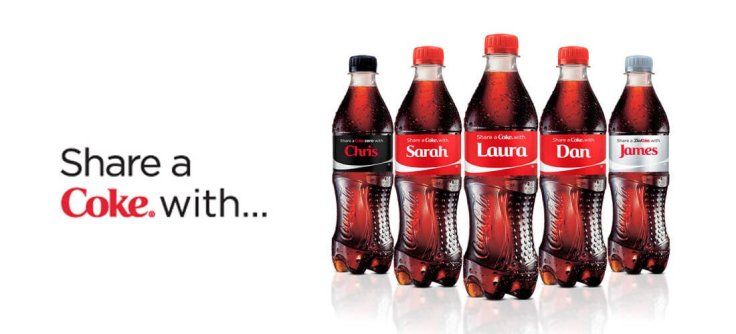
Paranormal Activity’s “Test Screening”
This marketing campaign was one of its kind as it changed its camera from the audience’s perspective to the audience itself. It held a test screening and recorded the actual reaction of the audience to highlight and promise a terrifying theatrical experience for all the viewers. This turned a film with an initial budget of $15,000 into a $193 million box office success.
Metro Trains’ “Dumb Ways to Die” Marketing Campaign
Created in Melbourne, this was Australia’s PSA campaign in order to encourage railway safety. It was initially shared on social media in 2012 but soon went viral then after. The campaign has a music video that shows the animated characters dying through amusing circumstances. Not only it got more than 50 million views on YouTube, 3.2 million shares on Facebook, but it was also retweeted 100,000 times on Twitter.
In fact, even its music became popular with it being charted on iTunes in 28 countries. Back then, this marketing campaign became the third most viral ad of all time. In fact, even today, this marketing campaign has its own Wikipedia page and a live website where the visitors can shop for toys, apparel, and even play games.
AirBnB’s “Made Possible by Hosts”
With the rise in the COVID-19 cases, companies like Airbnb started seeing endless losses. To combat it, Airbnb created a series of videos under the theme of “Made Possible by Hosts,” which showed appreciation for all those hosts who continued to accept guests despite the circumstances. This was unique, as it put not its customers but its hosts who accepted the customers in the first place at the center. Through this, Airbnb was able to focus on the human aspect of its platform- that you are not renting an Airbnb property but rather someone’s home.
How Can Deskera Help You With Marketing?
Deskera is a bunch of software with the sole purpose of meeting all your business needs. When it comes to your marketing needs, it is Deskera CRM and Deskera CRM+ that you should rely upon.
Deskera CRM is designed to manage and grow your customer base with ease while also offering an intuitive interface that lets you automate your marketing and support workflows. It lets you track your marketing KPIs so that you can not only know the performance of your ongoing marketing campaigns but also know what to change or improve in the next marketing campaigns.
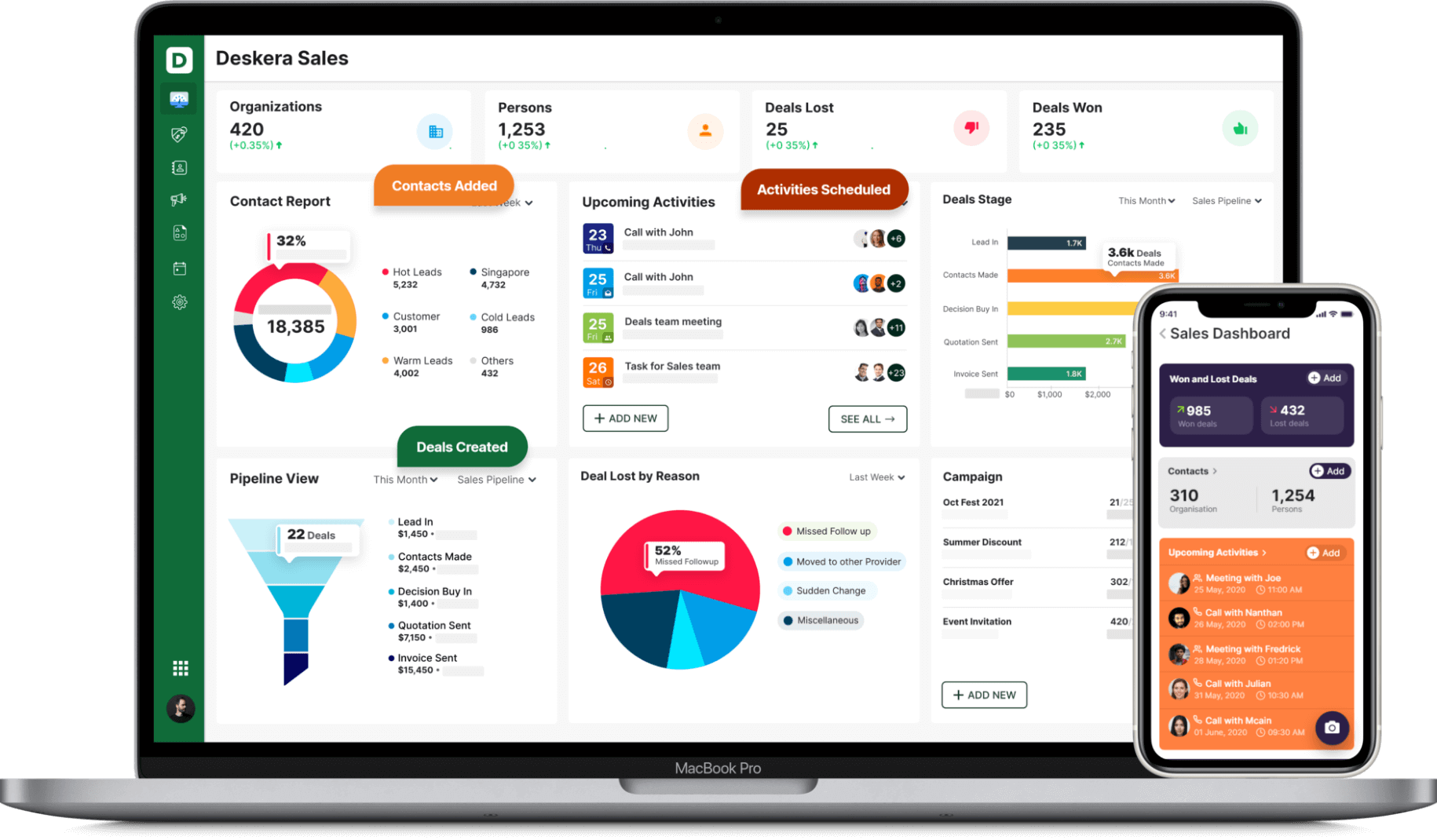
Tracking and analyzing these metrics will also help you assess whether your marketing campaign is worthwhile or not. Additionally, it will help you get a deeper understanding of your target audience and what they are expecting from your brand and your products and services.
Additionally, by using Deskera CRM, you would be able to accelerate the productivity of your marketing activities as you would be able to view and plan your campaigns on the calendar. In fact, not only would your team be on the same page with a calendar that can be updated in real-time and be assessed by all, but they would even get reminded of any tasks or deadlines that they might be forgetting.
In the case of Deskera CRM+, which is one of its kind CRM software, you would be able to design and track your landing pages, add lead magnets and forms to your pages and even have conversion-optimized templates for the same along with for email marketing.
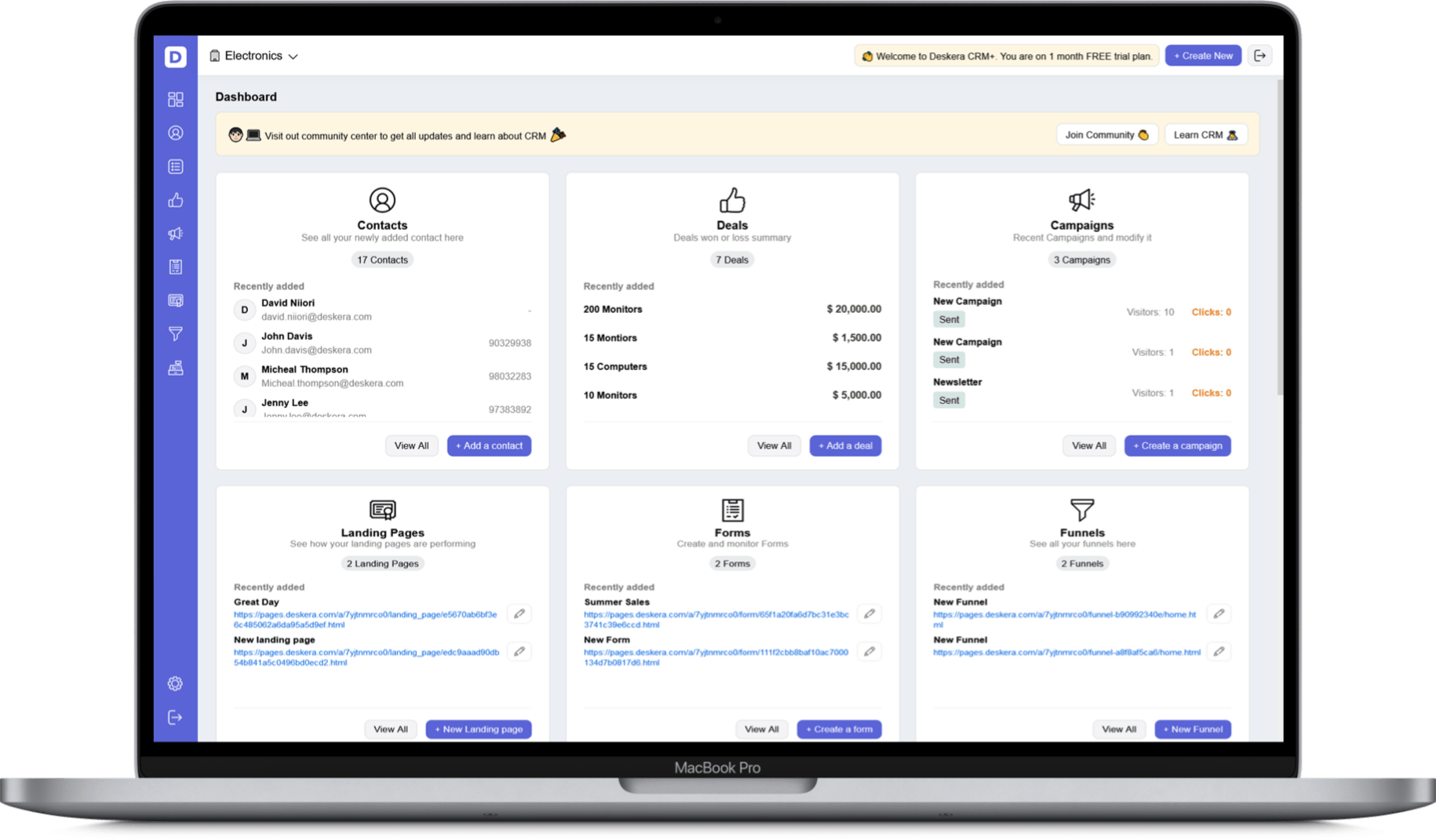
One of the other highlights of features offered by Deskera CRM+ is that it will even let you segmentize your contacts as per their interests and challenges so that later on, you can set up personalized marketing campaigns for each segment. This will increase your sales, profit, and even customer satisfaction.
Lastly, through Deskera’s web and mobile app, you would be able to create, manage and track your team’s activities, which will also let you build linked activities, letting your team take faster follow-ups and even close deals faster.
Key Takeaways
While marketing campaigns are not easy and very vulnerable to changes in consumers’ perception, behavior, market trends, and other such factors, they are important for the growth, development, and success of your business. Be it green marketing, sustainable marketing, agile marketing, or any other type of marketing, you should choose a marketing type that suits you and your business the best.
After choosing your marketing type and preferred channels, you should know the recent marketing trends so that you can increase the probability of your success. A successful marketing campaign is one that has helped you achieve your set SMART goal, increased customer retention, and even encouraged returning customers. It is also one that improves the state of your profit and loss statement, balance sheet, and other such financial statements.
Your marketing campaign should be creative, authentic, and exciting in its approach, for only then would it be able to grab your audience’s attention. Whilst you do all of this and more, software like Deskera CRM and CRM+ would be of great help to you in automating several marketing associated activities, hence saving you your time and efforts, which you can then focus on the other required areas.
Related Articles




